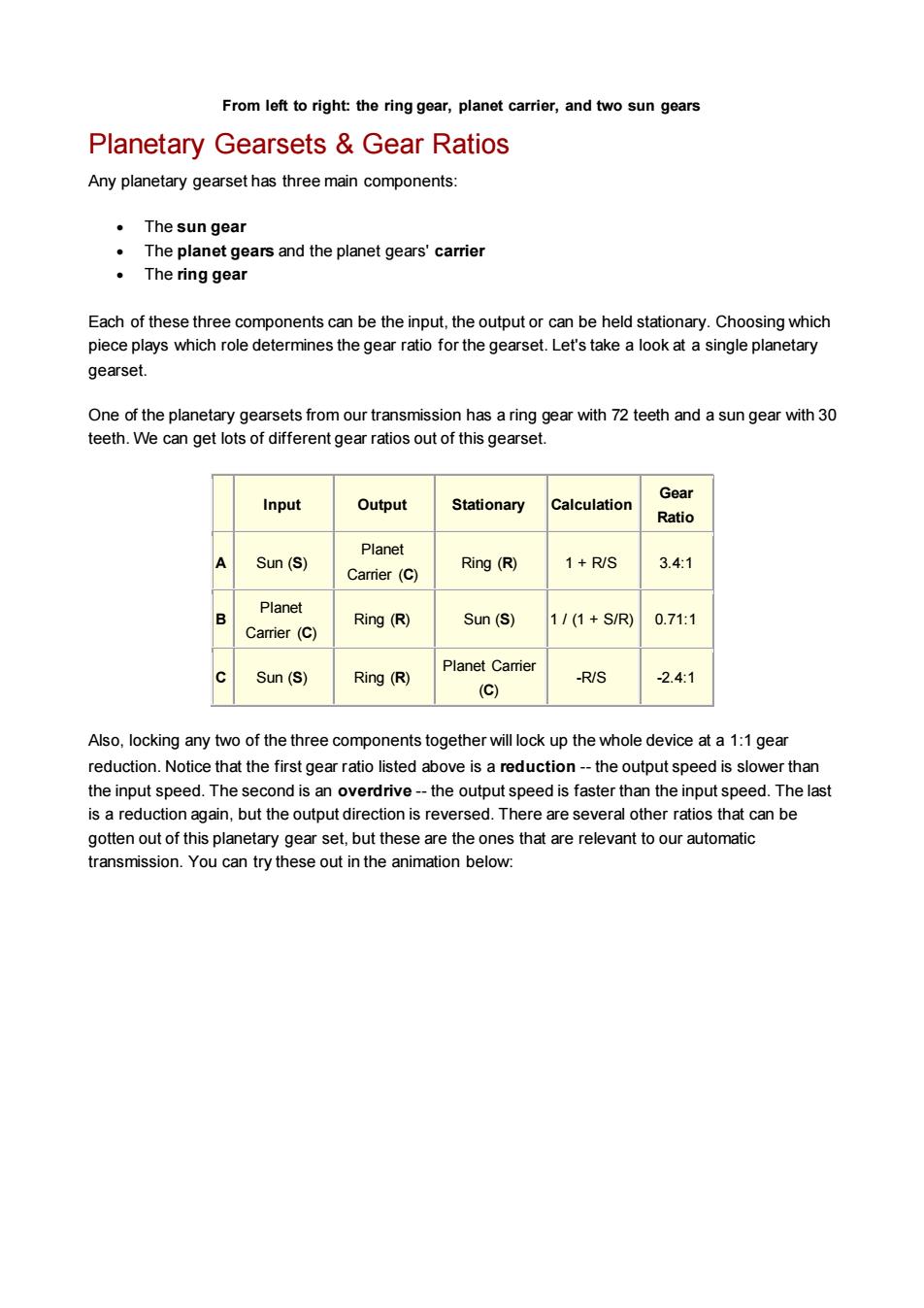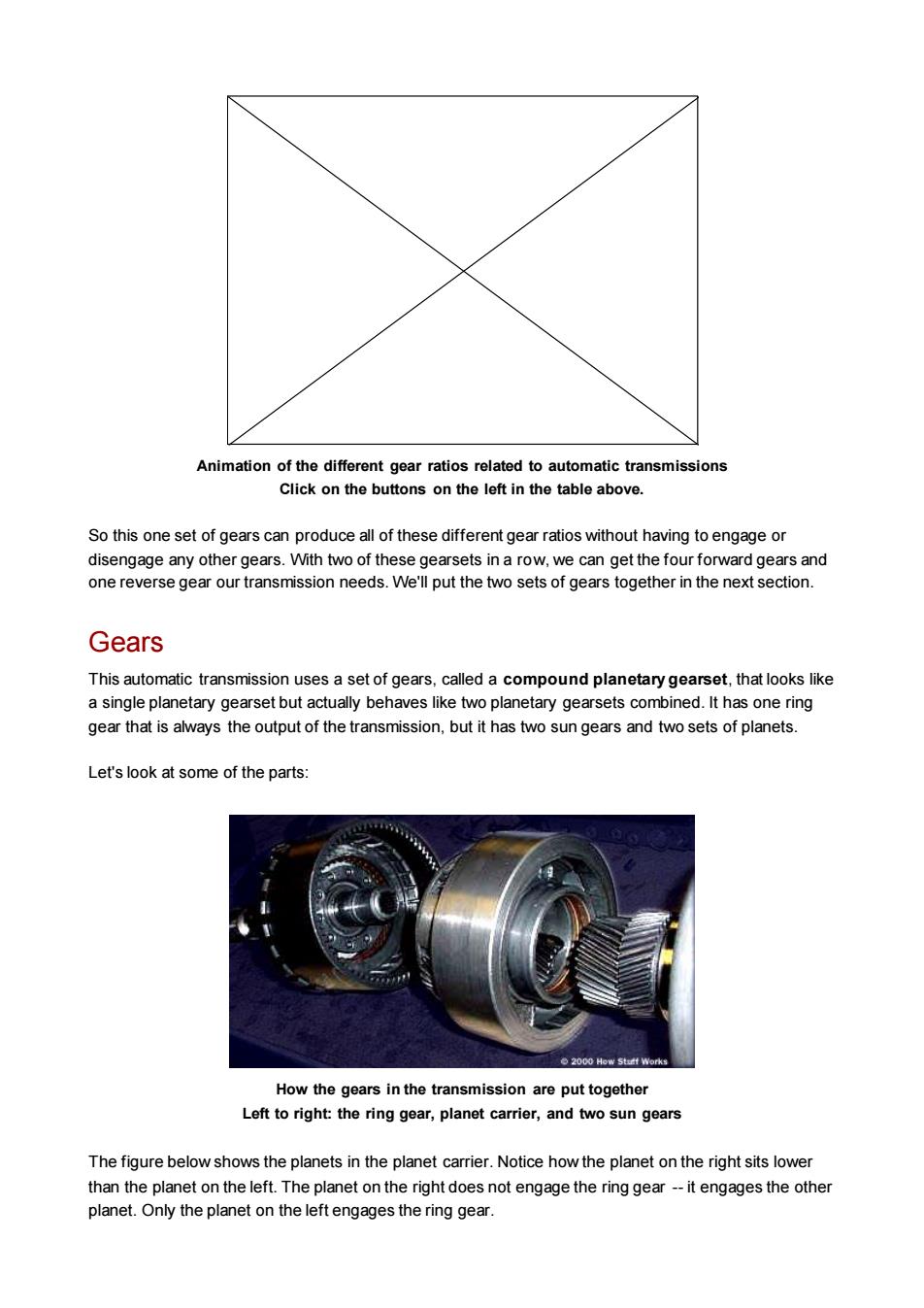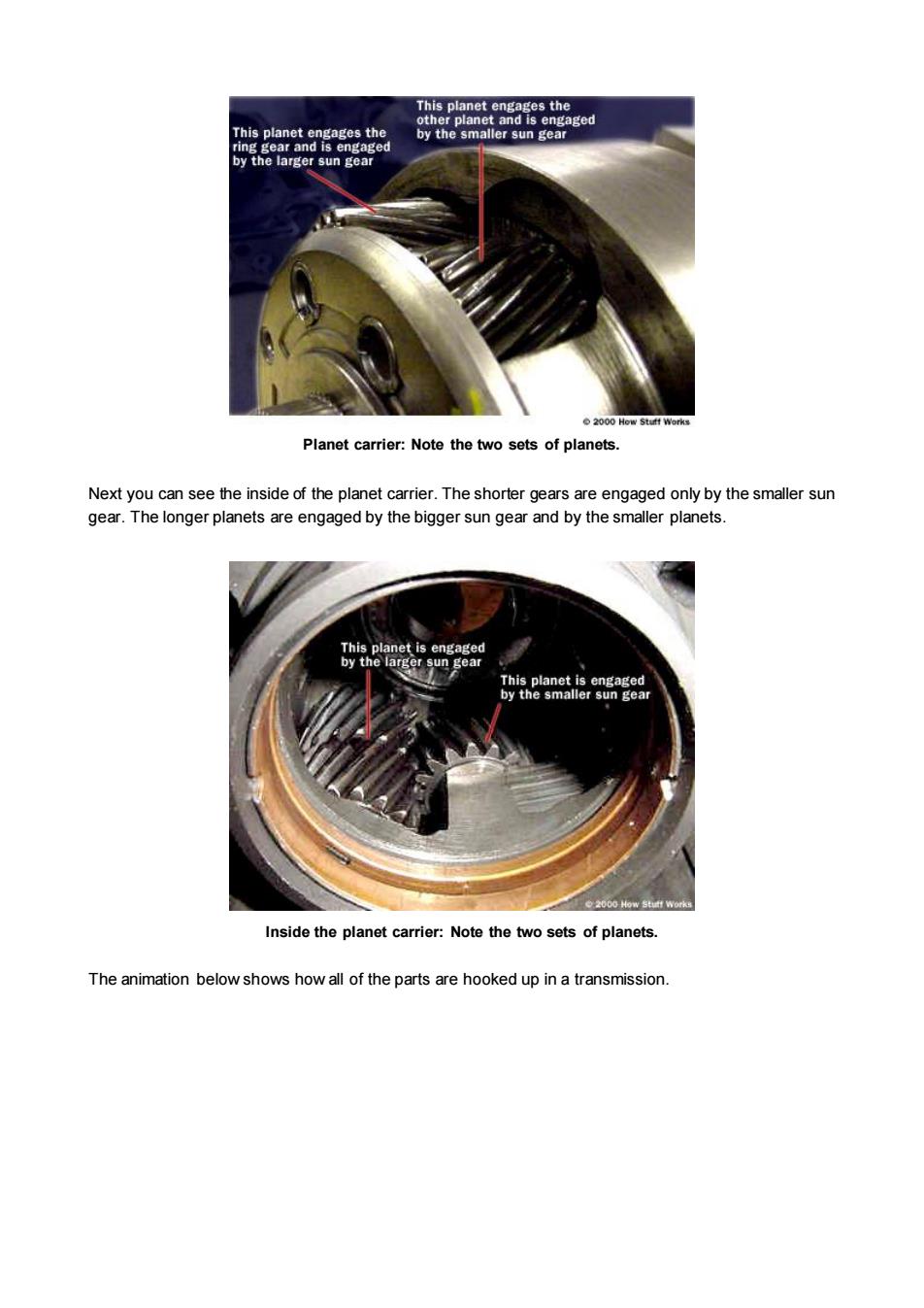
Fromlefttoright:theringgear,planetcarrier,andtwosungearsPlanetaryGearsets&GearRatiosAnyplanetarygearsethasthreemaincomponents:ThesungearTheplanetgears and theplanet gears'carrierThe ring gearEach of thesethreecomponentscan bethe input, theoutputor can beheld stationary.Choosingwhichpiece plays which role determines the gear ratio for the gearset. Let's take a look at a single planetarygearset.One of the planetary gearsets from our transmission has a ring gear with 72 teeth and a sun gear with 30teeth.We can get lots of different gear ratios out of this gearset.GearInputOutputStationaryCalculationRatioPlanet1 + R/S3.4:14Sun (S)Ring (R)Carrier (C)PlanetRing (R)Sun (S)1 / (1 + S/R)0.71:1BCarrier (C)PlanetCarrier-R/S-2.4:1Sun (S)Ring (R)C(C)Also,lockinganytwo ofthethree componentstogetherwillockupthewholedeviceata1:1gearreduction.Noticethat thefirstgearratio listed aboveisa reduction--theoutputspeedis slowerthanthe input speed.Thesecondisanoverdrive--theoutputspeedisfasterthantheinputspeed.Thelastisa reductionagain,buttheoutputdirectionisreversed.Thereareseveralotherratiosthatcanbegottenoutof thisplanetarygearset,butthesearetheonesthat arerelevanttoourautomatictransmission.You can trythese out in the animation below
From left to right: the ring gear, planet carrier, and two sun gears Planetary Gearsets & Gear Ratios Any planetary gearset has three main components: • The sun gear • The planet gears and the planet gears' carrier • The ring gear Each of these three components can be the input, the output or can be held stationary. Choosing which piece plays which role determines the gear ratio for the gearset. Let's take a look at a single planetary gearset. One of the planetary gearsets from our transmission has a ring gear with 72 teeth and a sun gear with 30 teeth. We can get lots of different gear ratios out of this gearset. Input Output Stationary Calculation Gear Ratio A Sun (S) Planet Carrier (C) Ring (R) 1 + R/S 3.4:1 B Planet Carrier (C) Ring (R) Sun (S) 1 / (1 + S/R) 0.71:1 C Sun (S) Ring (R) Planet Carrier (C) -R/S -2.4:1 Also, locking any two of the three components together will lock up the whole device at a 1:1 gear reduction. Notice that the first gear ratio listed above is a reduction - the output speed is slower than the input speed. The second is an overdrive - the output speed is faster than the input speed. The last is a reduction again, but the output direction is reversed. There are several other ratios that can be gotten out of this planetary gear set, but these are the ones that are relevant to our automatic transmission. You can try these out in the animation below:

Animation ofthe differentgearratiosrelated to automatic transmissionsClick on the buttons on the left in the table above.So this one set of gears can produce all of these different gear ratios without having to engage ordisengageany othergears.Withtwoof thesegearsets inarow,wecangetthefourforwardgearsandone reverse gear our transmission needs.We'll put the two sets of gears together in the next section.GearsThisautomatictransmissionusesasetofgears,calledacompoundplanetarygearset,thatlooks likea single planetary gearset but actually behaves like two planetary gearsets combined. It has one ringgear that is always the output of the transmission, but it has two sun gears and two sets of planets.Let'slookatsome oftheparts:Howthegears inthetransmission are puttogethelLeft to right: the ring gear, planet carrier, and two sun gearsThefigure below shows the planets in the planet carrier.Noticehowtheplanet on the right sits lowerthantheplanet ontheleft.Theplaneton therightdoesnot engagetheringgear--it engages theotherplanet.Onlytheplanetontheleftengagestheringgear
Animation of the different gear ratios related to automatic transmissions Click on the buttons on the left in the table above. So this one set of gears can produce all of these different gear ratios without having to engage or disengage any other gears. With two of these gearsets in a row, we can get the four forward gears and one reverse gear our transmission needs. We'll put the two sets of gears together in the next section. Gears This automatic transmission uses a set of gears, called a compound planetary gearset, that looks like a single planetary gearset but actually behaves like two planetary gearsets combined. It has one ring gear that is always the output of the transmission, but it has two sun gears and two sets of planets. Let's look at some of the parts: How the gears in the transmission are put together Left to right: the ring gear, planet carrier, and two sun gears The figure below shows the planets in the planet carrier. Notice how the planet on the right sits lower than the planet on the left. The planet on the right does not engage the ring gear - it engages the other planet. Only the planet on the left engages the ring gear

This planet engages theanetand is engagedotherplalThis planet engages thebythe smallersungearring gear and is engagedby the larger sun gear2000HowStuffWorkPlanetcarrier:Notethetwo setsofplanets.Next you can see the inside of the planet carrier.The shorter gears are engaged only by the smaller sungear.ThelongerplanetsareengagedbythebiggersungearandbythesmallerplanetsThis planet is engagedby the larger sun gearThisplanetis engagedbythesmallersungearInsidetheplanetcarrier:Notethetwosetsofplanets.Theanimationbelowshowshowallofthepartsarehookedupinatransmission
Planet carrier: Note the two sets of planets. Next you can see the inside of the planet carrier. The shorter gears are engaged only by the smaller sun gear. The longer planets are engaged by the bigger sun gear and by the smaller planets. Inside the planet carrier: Note the two sets of planets. The animation below shows how all of the parts are hooked up in a transmission